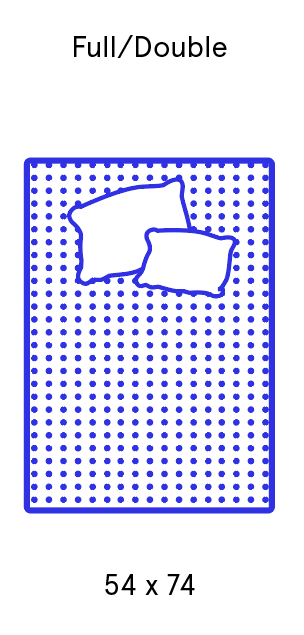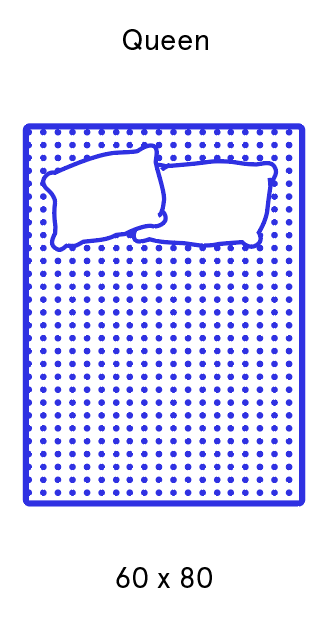Full/Double Mattress vs. Queen Mattress
Quick Overview
Mattress shoppers should take several factors into account when selecting the size of their new bed. These considerations include bedroom size, target price, and the number of people who plan to sleep on the mattress. Most mattresses sold today are available in six sizes: Twin, Twin Extra Long (XL), Full/Double, Queen, King, and California King. In addition, some models are sold in specialty and/or custom sizes.
This guide looks at similarities and differences between Full (or Double) and Queen sizes. First let’s look at some basic differences between these two sizes.
Key Differences and Similarities between Full/Double and Queen Sizes
The table below lists some notable differences and similarities between the Full/Double and Queen mattress sizes.
| Mattress Size | Full/Double | Queen |
| Standard width | 54 in. | 60 in. |
| Standard length | 74 to 75 in. | 80 in. |
| Ideal bedroom size | Minimum: 8.5 ft. wide x 10.25 ft. long | Minimum: 9 ft. wide x 11 ft. long |
| Average price range | $550 to $800 | $800 to $1,200 |
| Ideal sleeping arrangement | Single sleeper who is average height and prefers some extra sleeping space. | Single sleeper who prefers abundant space or couples that do not require much extra space. |
Pros and Cons of a Full/Double Size

The Full size, also known as a Double, measures roughly fifty-four inches (54″) wide by seventy-four to seventy-five inches (74-75″) long. This size offers a compromise between the standard Twin (39W” x 75L”) and standard Queen (60W” x 80L”) sizes. It is widely used in commercial accommodations, such as double-bed hotel rooms, college dormitories, and healthcare facilities.
Benefits of a Full size mattress include:
- Less space required: Because Full/Double mattresses are slightly thinner and shorter than Queens, they will fit into bedrooms with smaller dimensions.
- Lower price-point: With few exceptions, Full/Double mattresses are typically $100 to $400 cheaper than Queen-size designs of the same model. However, the average price-point of a Full/Double varies by brand, model, and mattress type. Sheets for Full/Double mattresses are usually less expensive than Queen-size sheets, as well.
- Extra space for single sleepers: A Full/Double mattress is suitable for single sleepers that like additional sleeping space; comparatively, Twin and Twin XL models offer little to no extra space for single sleepers.
- Wide availability: Most mattress models are available in a Full/Double size.
- Lighter and easier to move: The average Full/Double mattress weighs less than 80 pounds, making them fairly easy to move and maneuver without assistance compared to Queens.
Some drawbacks of a Full/Double mattress include the following:
- Not couple-friendly: Full/Double mattresses are not designed for more than one person, making them unsuitable for couples.
- Too small for larger rooms: While a Full/Double mattress will fit in some bedrooms that are too small for a Queen-size model, they may look out of place in bedrooms that cover above-average areas.
- Too short for exceptionally tall people: A Full/Double mattress measures 75 inches in length, meaning it will be too short for anyone who stands at 6’3″ or taller.
Pros and Cons of a Queen Size
 Queen mattresses are the most popular size, accounting for roughly 40% of all mattress sales. The Queen is considered an industry standard, and many manufacturers will use Queen prices as default display prices on mattress product pages.
Queen mattresses are the most popular size, accounting for roughly 40% of all mattress sales. The Queen is considered an industry standard, and many manufacturers will use Queen prices as default display prices on mattress product pages.
Benefits of a Queen-size mattress include the following:
- Extra space: A Queen-size mattress measures sixty inches (60″) wide by eighty inches (80″) long. This size offers more room for individual sleepers than a Full/Double. Additionally, Queens may be suitable for couples that do not require a lot of extra space; Full/Double sizes, on the other hand, are not suitable for couples.
- Wide availability: Because it is an industry standard, almost every mattress sold today is available in a Queen size.
- Long enough for most people: Queen-size mattresses measure roughly 80 inches in length, making them suitable for anyone that stands 6’7″ or shorter.
Drawbacks of Queen-size mattresses include the following:
- Higher price-point: The average Queen-size mattress is priced between $800 and $1,200, making them roughly $100 to $400 more expensive than the average Full/Double mattress. In rare cases, the Queen and Full/Double of a given model will share the same price-point.
- More space required: A bedroom should measure at least nine feet (9′) wide by eleven feet (11′) long in order to accommodate a Queen-size mattress. Smaller rooms may not provide adequate space for a Queen.
- Relatively heavy: The average Queen-size mattress weighs between 80 and 100 pounds. While this may be light enough for most people to move and maneuver without assistance, Full/Double mattresses are usually much lighter.
Is a Full/Double or Queen Size Right for You?
Do you sleep alone or with a partner?
Your sleeping situation should help you gauge whether a Full/Double or Queen size mattress is best. If you sleep alone you’ll require less sleeping space, so a smaller mattress will probably do just fine. If you share your bed with a partner, however, anything smaller than a Queen may feel cramped.
If you’re sleeping single, you may want to consider your future lifestyle and if you foresee any changes in your situation. Mattresses are a somewhat long-term investment, so it’s important to take into consideration what your future may look like as well. If you tend to move frequently, a smaller bed will be easier to take with you when you go and will fit in most standard size bedrooms. Considering the here and now as well as the days to come can help you choose a mattress that serves you well for many years.
What is your body type?
Body type can play a large role in what mattress size will work for you. For most single sleepers, a Full-size mattress will usually do. If you like to sprawl out on the other hand, or prefer to sleep away from the edge of your mattress, a Queen size is probably the better option between the two. If you have an adult sleeping partner, body size can make an even bigger difference. Though the extra 5 inches in length on a Queen may not seem like a lot, those extra inches can really count when it comes to sleeping comfortably with your partner.
Do children and/or pets frequently share your bed?
If you have them, pets and/or children can quickly fill up a mattress. If you’re a pet owner that makes room for your furry friends in bed you will probably want as much room as possible. A Full/Double size mattress is going to be smaller and shorter than a Queen, meaning less cuddle room for all of you. As children grow, they’ll require more and more space when you co-sleep. More can be merrier in your bed so long as you provide ample room for everyone.
How do you position your body when you sleep?
Sleeping position can be a huge deciding factor in choosing between a Queen and a Full/Double size mattress. Whether it’s side, back, or stomach sleeping, the right bed will help you get into a position that’s comfortable while providing enough room to move about. If you’re a stomach sleeper you might stretch your legs out and require extra width from your bed. A back sleeper (especially one over 6’2”), will likely be most comfortable in a mattress that provides that additional length.
If you’re sharing your bed with a partner, keep in mind their preferred sleeping position as well. If both of you like to sprawl out or tend to change sleeping positions frequently throughout the night, a mattress that provides extra width will make for a happier and less disruptive night’s rest.
How much bedroom space do you have?
Whether you live in a studio or a large master suite, your mattress should fit comfortably in your space. If you have other large pieces of furniture taking up space in your room, opting for a smaller bed may be a wise choice. You should also factor in the layout of a room. If the bed has to be placed in front of a window or has to be arranged in between a closet door, then the more versatile Full-size bed may be a better option.
Even though there isn’t a huge size dimension difference between the two, the extra length and width can make a world of difference if you’ll be sleeping in a smaller sized room. Take a look at the following standard sizes of all mattresses so you can fit one into your square footage with ease.
- Twin: 2,925 sq. in./20.3 sq. ft.
- Twin XL: 3,120 sq. in./21.7 sq. ft.
- Full: 4,050 sq. in./28.1 sq. ft.
- Queen: 4,800 sq. in./33.3 sq. ft.
- King: 6,080 sq. in./42.2 sq. ft.
- California King: 6,048 sq. in./42 sq. ft.
What is your mattress shopping budget?
For many shoppers, the ultimate mattress buying decision comes down to money. Since Full-size beds are cheaper, those on a tighter budget may get a Full over a Queen. You can also likely score a bargain for a Queen-size bed if you select a model from a more affordable mattress brand.
Because a mattress is an investment in your future and the quality of your sleep environment, you should try not to settle for a poor-quality mattress in order to save money. Plan ahead and start saving for a mattress, or shop for a sale-priced model during popular retail holidays. Once you’ve determined which size is the best fit for your needs, you can incorporate your budget into the equation and find a mattress that rests easy with your pocketbook as well as your pillow.
Conclusion
The Full/Double mattress is ideal for single sleepers who are 6’2″ or shorter and desire a little extra width than is offered by a standard twin size. While they do not provide enough space for couples, Full/Double models may be ideal for guest room accommodations, as well as commercial and temporary residential settings (such as motels and college dorms).
A Queen-size is suitable for single sleepers who desire even more extra space, as well as couples who don’t mind narrow sleep surfaces.
However, these findings are largely subjective. For shoppers who are unsure which size will best serve them, we suggest testing out both sizes in brick-and-mortar mattress stores, and also taking part in mattress sleep trials that allow them to sleep on Full/Double and Queen mattresses for longer periods of time and then return the model that they find the least satisfactory.